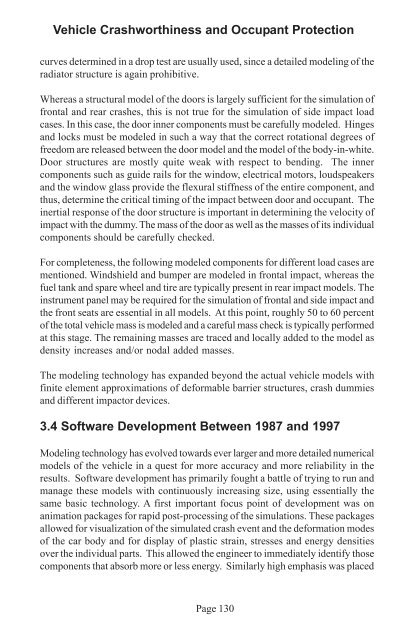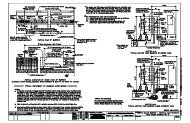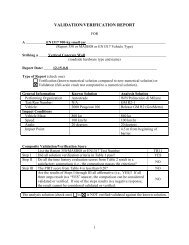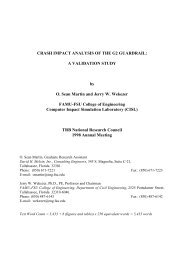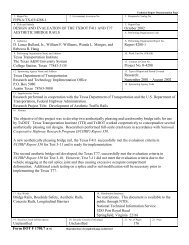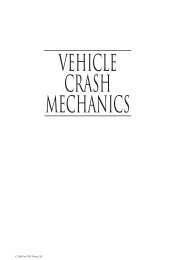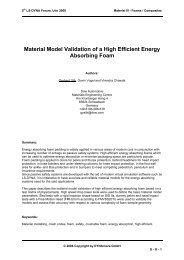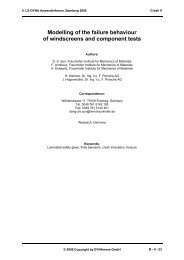Vehicle Crashworthiness and Occupant Protection - Chapter 3
Vehicle Crashworthiness and Occupant Protection - Chapter 3
Vehicle Crashworthiness and Occupant Protection - Chapter 3
Create successful ePaper yourself
Turn your PDF publications into a flip-book with our unique Google optimized e-Paper software.
<strong>Vehicle</strong> <strong>Crashworthiness</strong> <strong>and</strong> <strong>Occupant</strong> <strong>Protection</strong><br />
curves determined in a drop test are usually used, since a detailed modeling of the<br />
radiator structure is again prohibitive.<br />
Whereas a structural model of the doors is largely sufficient for the simulation of<br />
frontal <strong>and</strong> rear crashes, this is not true for the simulation of side impact load<br />
cases. In this case, the door inner components must be carefully modeled. Hinges<br />
<strong>and</strong> locks must be modeled in such a way that the correct rotational degrees of<br />
freedom are released between the door model <strong>and</strong> the model of the body-in-white.<br />
Door structures are mostly quite weak with respect to bending. The inner<br />
components such as guide rails for the window, electrical motors, loudspeakers<br />
<strong>and</strong> the window glass provide the flexural stiffness of the entire component, <strong>and</strong><br />
thus, determine the critical timing of the impact between door <strong>and</strong> occupant. The<br />
inertial response of the door structure is important in determining the velocity of<br />
impact with the dummy. The mass of the door as well as the masses of its individual<br />
components should be carefully checked.<br />
For completeness, the following modeled components for different load cases are<br />
mentioned. Windshield <strong>and</strong> bumper are modeled in frontal impact, whereas the<br />
fuel tank <strong>and</strong> spare wheel <strong>and</strong> tire are typically present in rear impact models. The<br />
instrument panel may be required for the simulation of frontal <strong>and</strong> side impact <strong>and</strong><br />
the front seats are essential in all models. At this point, roughly 50 to 60 percent<br />
of the total vehicle mass is modeled <strong>and</strong> a careful mass check is typically performed<br />
at this stage. The remaining masses are traced <strong>and</strong> locally added to the model as<br />
density increases <strong>and</strong>/or nodal added masses.<br />
The modeling technology has exp<strong>and</strong>ed beyond the actual vehicle models with<br />
finite element approximations of deformable barrier structures, crash dummies<br />
<strong>and</strong> different impactor devices.<br />
3.4 Software Development Between 1987 <strong>and</strong> 1997<br />
Modeling technology has evolved towards ever larger <strong>and</strong> more detailed numerical<br />
models of the vehicle in a quest for more accuracy <strong>and</strong> more reliability in the<br />
results. Software development has primarily fought a battle of trying to run <strong>and</strong><br />
manage these models with continuously increasing size, using essentially the<br />
same basic technology. A first important focus point of development was on<br />
animation packages for rapid post-processing of the simulations. These packages<br />
allowed for visualization of the simulated crash event <strong>and</strong> the deformation modes<br />
of the car body <strong>and</strong> for display of plastic strain, stresses <strong>and</strong> energy densities<br />
over the individual parts. This allowed the engineer to immediately identify those<br />
components that absorb more or less energy. Similarly high emphasis was placed<br />
Page 130


